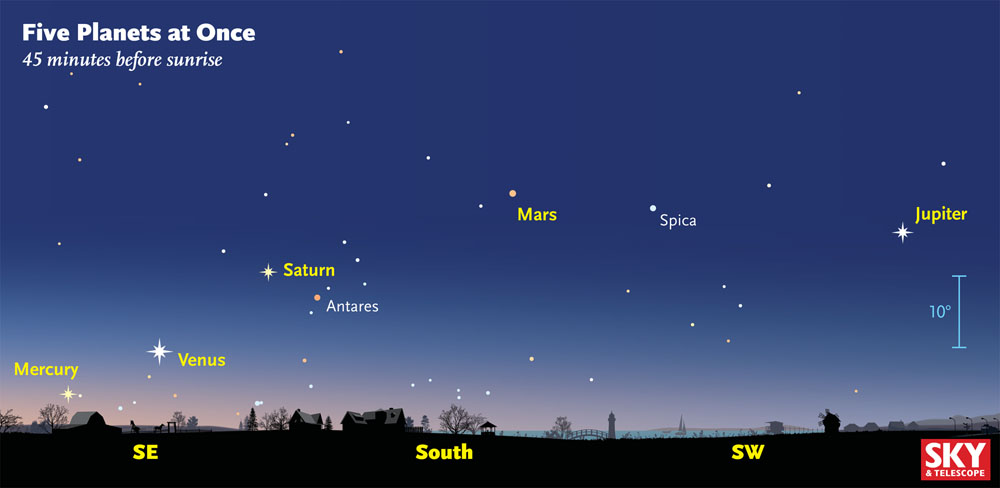
All five naked-eye planets are visible in early dawn — especially by late in the week, when Mercury comes into its own. See our article Get Up Early, See Five Planets at Once!. Media and bloggers: Use the info and graphics in our press release.
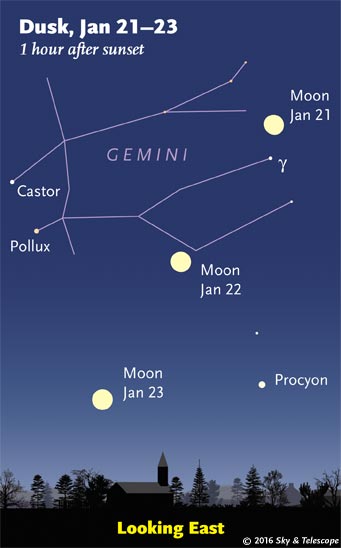
Friday, January 22
• The nearly-full Moon shines in Gemini this evening — with Castor and Pollux to its left or upper left, and brighter Procyon lower right of it, as shown at right.
• On the other side of the sky, the big Northern Cross of Cygnus plants itself upright on the northwest horizon soon after the end of twilight.
Saturday, January 23
• Full Moon (exact at 8:46 p.m. EST). As the Moon climbs the eastern sky, look for Pollux and Castor above it and Procyon to its right, as shown here. The Moon is currently 4° south of the ecliptic; in a telescope, look for features on its northern limb casting extremely thin shadows even at the time of full Moon.
Sunday, January 24
• Bright Capella high overhead, and equally bright Rigel in Orion’s foot, are at almost the same right ascension. This means they cross your sky’s north-south meridian at almost the same time (around 9 p.m. now, depending on how far east or west you live in your time zone). So whenever Capella passes its very highest overhead, Rigel marks true south over your landscape. And vice versa.
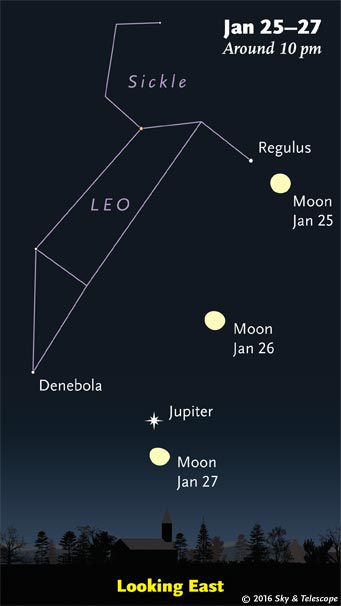
Monday, January 25
• The waning gibbous Moon rises not long after dark, with Regulus glimmering only about 3° to its left (for skywatchers in North America). Later in the night Regulus shines upper left of the Moon, as shown here.
Tuesday, January 26
• Jupiter shines lower left of the Moon after they rise in mid-evening. A small telescope will show Jupiter's moon Europa fading away into eclipse by Jupiter's shadow around 9:32 p.m. Eastern Standard Time (when Jupiter will still be low for Easterners, and not yet risen farther west). Ganymede, slightly brighter than Europa, will shine right next to it!
• Jupiter's now-prominent Great Red Spot crosses Jupiter's central meridian about three hours later: around 12:21 a.m. EST.
Wednesday, January 27
• The waning gibbous Moon doesn't rise until about 9 p.m. now (depending on your location), giving you a two-hour window of dark-sky observing after nightfall. When the Moon comes up, it'll have a bright companion: Jupiter standing a few degrees above it (for North America).
Thursday, January 28
• The sky's biggest asterism (informal star pattern) — or at least, the biggest one that's widely recognized — is the Winter Hexagon. It fills the sky toward the east and south these evenings. Start with brilliant Sirius at its bottom. Going clockwise from there, march through Procyon, Pollux and Castor, Capella high up, Aldebaran over to Capella's right, down to Rigel in Orion's foot, and back to Sirius.
Friday, January 29
• Sirius blazes high in the south on the meridian by about 10 p.m. now. Using binoculars, examine the spot 4° south of Sirius (directly below it when on the meridian). Four degrees is somewhat less than the width of a typical binocular's field of view. Can you see a little patch of gray haze there? That's the open star cluster M41, about 2,200 light-years away. Sirius, by comparison, is only 8.6 light-years away.
• The eclipsing variable star Algol will be at minimum light, magnitude 3.4 instead of its usual 2.1, for a couple hours centered on 9:05 p.m. EST.
• If you go out Saturday morning for the dawn planet panorama, you'll find the waning Moon upper left of Spica. Off to their left, Mars will be 1½° from fainter Alpha Librae, a wide binocular double star.
Saturday, January 30
• As soon as it's fully dark, spot the equilateral Winter Triangle in the southeast. Sirius is its brightest and lowest star. Betelgeuse stands above Sirius by about two fists at arm's length. To the left of their midpoint shines Procyon.
And standing directly above Procyon now (depending on your latitude) is 3rd-magnitude Beta Canis Minoris, the only other easy naked-eye star of Canis Minor.
__________________________
Want to become a better astronomer? Learn your way around the constellations. They're the key to locating everything fainter and deeper to hunt with binoculars or a telescope.
This is an outdoor nature hobby. For an easy-to-use constellation guide covering the whole evening sky, use the big monthly map in the center of each issue of Sky & Telescope, the essential guide to astronomy.
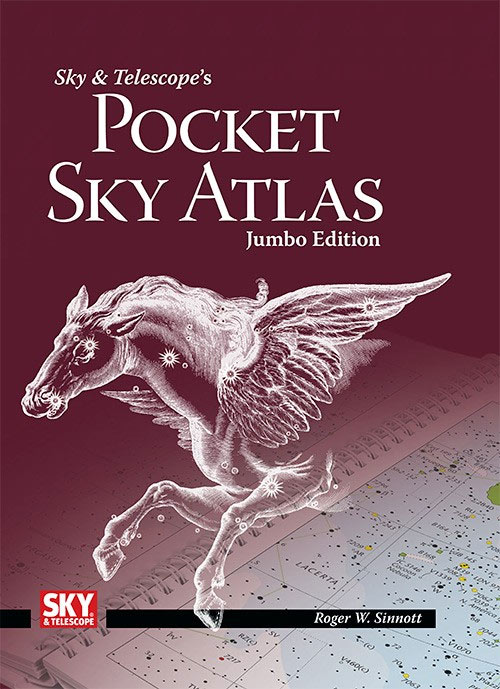
Once you get a telescope, to put it to good use you'll need a detailed, large-scale sky atlas (set of charts). The basic standard is the Pocket Sky Atlas (in either the original or new Jumbo Edition), which shows stars to magnitude 7.6.
Next up is the larger and deeper Sky Atlas 2000.0, plotting stars to magnitude 8.5, nearly three times as many. Next up, once you know your way around, is the even larger Uranometria 2000.0 (stars to magnitude 9.75). And read how to use sky charts with a telescope.
You'll also want a good deep-sky guidebook, such as Sue French's Deep-Sky Wonders collection (which includes its own charts), Sky Atlas 2000.0 Companion by Strong and Sinnott, or the bigger Night Sky Observer's Guide by Kepple and Sanner.
Can a computerized telescope replace charts? Not for beginners, I don't think, and not on mounts and tripods that are less than top-quality mechanically (meaning heavy and expensive). As Terence Dickinson and Alan Dyer say in their Backyard Astronomer's Guide, "A full appreciation of the universe cannot come without developing the skills to find things in the sky and understanding how the sky works. This knowledge comes only by spending time under the stars with star maps in hand."
This Week's Planet Roundup
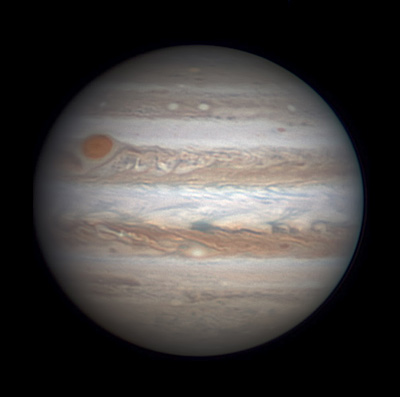
All five classical naked-eye planets are visible during dawn, as shown at the top of this page.
Mercury and Venus are low in the southeast. Look about 40 to 60 minutes before your local sunrise time; Venus is bright and obvious at magnitude –3.9. Look lower left of it for fainter Mercury (about magnitude +0.5). Mercury becomes easier to see during the course of the week; it's brightening and also moving a little higher. Venus and Mercury are 16° apart on the morning of January 23rd, and 8° apart by the 30th.
Saturn (magnitude +0.5, in Ophiuchus) shines as far or farther to Venus's upper right. Spot twinkly orange Antares (magnitude +1.1) 7° to the lower right of Saturn.
Mars (magnitude +1.0, in Libra), glows yellow-orange farther to the upper right: high in the south in early dawn.
Jupiter (magnitude –2.3, between Leo and Virgo) rises in the east around 9 p.m., shines highest in the south around 3 a.m., and moves over to dominate the west-southwest by the time the other planets are up during early dawn.
Uranus (magnitude +5.8, in Pisces) is still in the southwest just after dark. Finder chart.
Neptune (magnitude +7.9, in Aquarius) is sinking away low in the west after dark.
Planet Nine (probably fainter than magnitude 22, and probably not in the zodiac) seems reasonably likely to be out there, but where we can't say. It could be anywhere along a wide range of orbits supposedly inclined roughly 30° to the ecliptic. And it's most likely to be near its aphelion, hundreds or even 1,000 a.u. away.
__________________________
All descriptions that relate to your horizon — including the words up, down, right, and left — are written for the world's mid-northern latitudes. Descriptions that also depend on longitude (mainly Moon positions) are for North America.
Eastern Standard Time (EST) is Universal Time (UT, UTC, or GMT) minus 5 hours.
__________________________
“This adventure is made possible by generations of searchers strictly adhering to a simple set of rules. Test ideas by experiments and observations. Build on those ideas that pass the test. Reject the ones that fail. Follow the evidence wherever it leads, and question everything. Accept these terms, and the cosmos is yours.”
— Neil deGrasse Tyson
 2
2








Comments
Anthony Barreiro
January 22, 2016 at 6:12 pm
Including the hypothetical Planet Nine in "This Week's Sky at a Glance" is a bit of a stretch! 🙂
You must be logged in to post a comment.
January 22, 2016 at 11:32 pm
I love it when the full moon is coming out, best time of the month in my opinion!
You must be logged in to post a comment.
You must be logged in to post a comment.